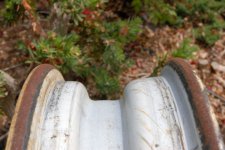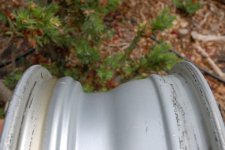John,
This is my understanding of the wheels/ty(i)res stuff, and, as usual, I'm willing to be corrected if wrong -
In the old days of spoked wheels pneumatic tyres needed tubes because the wheels (and tyres) were not air proof. However because of the double layer of rubber, tubed tyres were not very efficient at transferring the heat generated within the tyre out through the sidewall. This was not much of a problem at low speed but as road speeds rose there was a need for tyres to transmit more heat much more efficiently. Along came tubeless tyres and with them better rims boasting a complete air seal and good heat transfer.
Unfortunately, when partially or completely deflated, tubeless tyres had a tendency to peel off the rim under cornering forces as the bead separated from the inside of the metal rim.
So better beads and the concept of safety rims came along. Safety rims have either a circumferential hump or groove on each side of the inner part of the rim to help retain the bead when the tyre is partially inflated- couple of photos attached.
Today's tyres are very well made and as long as they are kept optimally inflated, will be safe up to their designated speed maxima on any undamaged rim. If you feel as though you must fit a tube to a tubeless tyre for reasons of 'safety', be aware that you will significantly lower the maximum speed at which the tyre can be run for reasons of heat generation and transfer. Personally, I would never tube a tubeless tyre as it may invalidate the manufacturers warranty.
My car has standard steel 126 rims and is fitted with tubeless 145R12 radial tyres. They are inflated to the correct pressures. The tyre fitter is happy, the insurance company is happy, I'm happy and all is good. However, you should check with your local authorities and tyre fitters as life may be different where you live.
Hope this helps,
Chris
PS: Rim profiles (eg: J, JJ, B, D etc.) are a black art for me and I have no comprehension of the meaning or significance of the letters stamped on the inside of the wheels.
 ). Is it the wheel that requires tube tires, or is it the tire?
). Is it the wheel that requires tube tires, or is it the tire?


